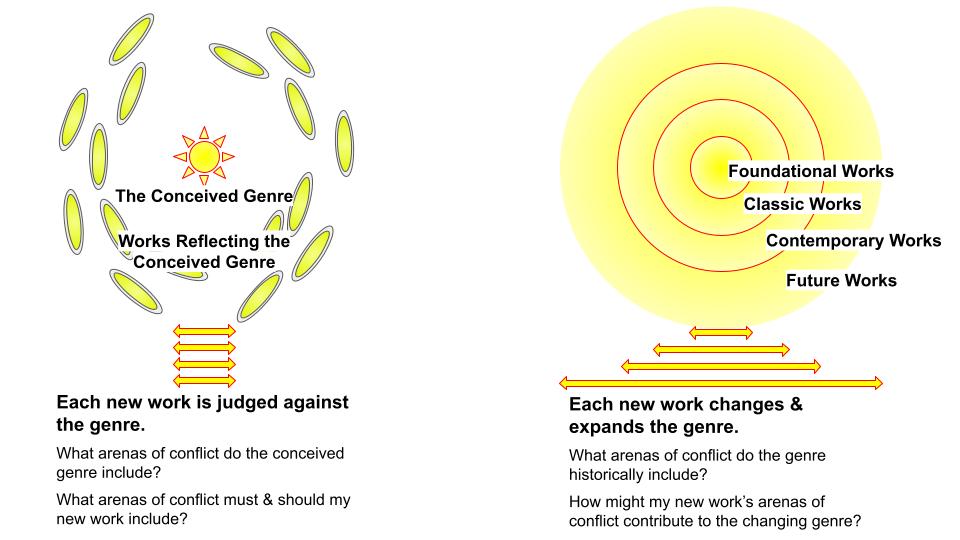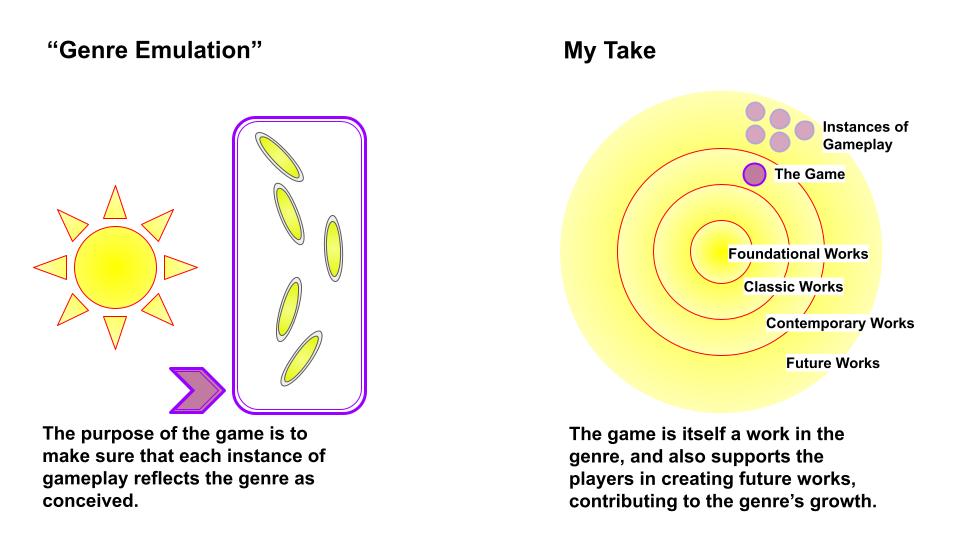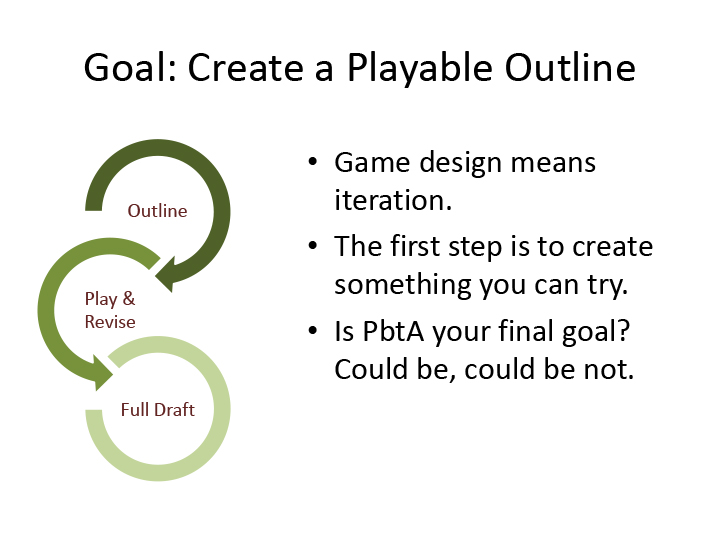Using Apocalypse World to Outline and Draft Your Own RPG
Here in Part 7, I’m setting aside some time for a good old straightforward Q&A.
I’ve gotten enough questions, and they’re challenging enough, that I’m taking them in rounds. Here’s round 1!
This article was made possible by the generous support of my patrons. Please consider joining them by supporting me on Patreon.
Let’s get right into it!
Q:
I wonder if this hasn’t been answered elsewhere but: Why is the break 2-6, 7-9, 10-12 and not 2-5, 6-8, 9-12? (Sorry if this isn’t true of AW, I’ve only played DW).
@twatbrillig
Ha! Totally.
In Apocalypse World, the average stat is +1. This is a bit of sleight-of-hand to make you feel badass: putting the stats on a -2 to +2 scale makes +0 feel like the average, so giving you stats that actually average to +1 makes you feel above average.
Since your stats average to +1, I centered the result curve on 8 instead of 7.
Giving you stats that actually average to +0, and centering the result curve on 7, would have given the game a more rationalist, constrained, moderated tone, where I was going for something more cinematic, expressionist, and over-the-top.
That’s why!
Q:
I have one question: I always felt when playing AW (in comparisons to other PbtA games) that Id like a bigger percentage of moves to be about choices and less about “setups” or “modifiers” as you called them in the beggining of this article. What do you think about this kind of moves, would you still implement them as much in a new project?
Julián Vecchione
I don’t mind them. They rest on the foundation of the basic moves, I’d say, and if the basic moves are good, modifier moves are fine.
For instance, in Apocalypse World, some of the playbooks have more different, unique, specialized decisions to make, like the Maestro D’, where other playbooks, like the Gunlugger, have fewer. I wouldn’t change this, it follows pretty directly from the set and nature of the basic moves. The effect is that you have characters who can do things that others can’t, and you have characters who’re better at the things everybody can do, and I think this serves Apocalypse World’s needs.
As far as new projects go…
- In Burned Over, we’re including fewer stat substitutions and simple bonuses, and more narrative modifiers, like the moves that let you ask additional specific questions when you read a person or a situation.
- Under Hollow Hills doesn’t have modifier moves at all.
- In The Wizard’s Grimoire etc., there are a few modifier moves, but their approach to basic moves is more fine-tuned to the playbooks in the first place.
So you might guess that we were moving away from them as a matter of principle…
…But we’re not! It’s just a coincidence.
I can see designing a game that only has basic moves and setup & modifier moves, just as easily, if that was what the game called for.
Q:
An issue I’ve had a few times while dabbling around with game design is a tendency to attach more and more mechanics to things. Is there a way to reframe one’s process of designing beyond just slowly unlearning more simulationist tendencies?
@AscatonicRilby
Yeah, absolutely. I have a concrete practical suggestion:
Work on the graphic design of the character sheet and player reference material while you’re working on the game design.
Never consider your game design to be done until you have the player reference material done, solid, finished, and real too.
While you’re designing a game, you want always to be thinking in the most explicit terms about how the players are going to encounter, remember, and interact with its systems.
If there’s not visual room for it on the character sheet, there’s not conceptual room for it in the rules!
You don’t have to be a good graphic designer. You’re just making a prototype. But your play materials are a real constraint on your game and they’ll help you create the game you want to create.
Q:
Okay but what if my design goal is to maximize hostility among players, like Settlers of Catan or Monopoly?
@spiral_dice
You joke (I presume), but I’ve been working on a presentation about violatory games for a while now. In rough order from most okay to least okay:
- Those figure-out-the-rules games where some people are in on it and others aren’t;
- Trust-under-pressure games like Diplomacy and Dragon’s Gold;
- Otherwise harmless games with unwitting players;
- Poorly designed games with unforeseen emergent malignant pressures*;
- The Dollar Auction;
- Hazing games;
- Addiction-exploiting games;
- Sports where the health risks are covered up, like CTE in football;
- Casino games against the house;
- The heavy hitter of all malignant games: scratch tickets and the lottery.
* Here’s where I’d list your examples, Settlers of Catan and Monopoly. Also a large number of RPGs, including maybe the biggest names. These are games that create the illusion of consent, make consent into a trap: you agree to follow the rules, but then the emergent systems turn on you, putting you in a bind between your agreement to your friends on the one hand, and your consent to what’s happening on the other. Dirty stuff.
But, anyway, I think we have a lot to learn from them! I think that if we care about humane, trust-affirming, friendship-building games, we’d do well to study and understand inhumane, exploitative, trust-eroding, and violatory games too. Up to and including designing them ourselves, sometimes. They’re what we’re up against, like.
Q:
What do you think are the arena of conflicts for sword & sorcery? How they might differ from those from Apocalypse World or Poison’d?
João Talassa
This question’s a doozy!
I think I’d better start by talking seriously about genre.
And of course, by “talking seriously,” I mean “drawing a diagram.” Here are two ways to look at genre.

The first point of view: The genre exists in some kind of pure, conceptual, notional, or abstract form. Creative works in the genre reflect, each in its own way, that conceptual genre. (The ovals are little mirrors, it’s a cute visual pun. Go with me here.)
This is the point of view that would try to identify the genre’s correct arenas of conflict. It’s the point of view that says, “but is this game really Sword & Sorcery?” It says, “in order to make it a Sword & Sorcery game, what arenas of conflict must it have?”
The second point of view: The genre exists as an accumulation of creative works. It began with its foundational works and established its identity with its classics, but as there have continued to be contemporary works in the genre, each one has changed and expanded it, and future works will change it even further.
From this point of view, there’s no such thing as the correct genre. Instead, we can look at the arenas of conflict that the genre has historically included, but we can also think about where the genre’s going next and how the work we’re doing now can shape its future.
As you might guess, I’m going to address your question from the second point of view. Not, “what arenas of conflict are correctly Sword & Sorcery,” but “what arenas of conflict might make for exciting new Sword & Sorcery?”
So that’s genre and now I’d better tell you my point of view on Sword & Sorcery. It’s this: Howard, Leiber, Vance and them are fine, but if we’re talking seriously about Sword & Sorcery, we’re talking about Tanith Lee. Including Tanith Lee’s work in the discussion radically changes the arenas of conflict we’re going to consider: contra those other dudes’, her Sword & Sorcery is feminist, humanist, expansive, and compassionate, while still being bloody, visceral, vigorous, and extremely weird.
Whew. Now I can try to answer your question.
Amazons
I made a Sword & Sorcery PbtA game a few years ago, as a tribute to Tanith Lee. It’s about Amazons, and my conception of its characters is literally, are you sword, or are you sorcery? Here are its moves.
As an Amazon, you have the power to…
- Call others to action;
- Rise to a threat;
- Reach out in compassion;
- Surpass your own limits;
- Bring forth a nightmare;
- Count the living and the dead;
- Name sorcery;
- Endure;
- Labor; and
- Commit yourself to violence.
The arenas of conflict that they point to are few, they’re like…
- Overcoming fears, reluctance, and disunity (your own and others’);
- Physical striving;
- Sorcery, nightmare-magic, and death-magic; and
- Violence.
…And I think that’s a pretty solid take.
The Unnamed World
As it happens, I’m working on another Sword & Sorcery game right now. It takes inspiration from the usual sources, plus a solid helping of, like, Samurai Jack, She-Ra and the Princesses of Power, and Thundarr the Barbarian.
It’s basic moves are:
- Prepare yourself;
- Read a situation;
- Face danger;
- Attack someone;
- Defend yourself;
- Interrupt someone;
- Move into position;
- Get to work;
- Spend time with someone;
- Stand your ground;
- Study the skies; and
- Unbind the unseen.
They point to almost the same arenas of conflict:
- Readying and resolving yourself, psychologically and physically;
- Taking care of others;
- Physical striving;
- Violence; and
- Magic.
The basic moves are less weird than the ones in Amazons, obviously, but you can see the different influences in the arenas of conflict too. The game inspired by Samurai Jack concerns itself with how you prepare yourself internally for action, while the game inspired by Tanith Lee concerns itself more with how you unite with others to stand up together.
Q:
I’ve often seen PbTA described as a genre/tropes – educator/emulator/enforcer, either that this is the system’s strongest point or that it was its essence. What’s your take?
Gherhartd S.
As it happens, this question’s been on my mind a bit lately, so I have a take all set to go.

My take is, my games aren’t genre emulation. They’re work in their genres, plain and simple. When you play them, you aren’t emulating those genres, you’re just plain no-bones making new fiction in them. There’s absolutely nothing “emulate” about it.
I can’t speak to other PbtA games! Maybe some of them are designed to teach, emulate, or enforce genre. But my guess is that most of us PbtA designers think of ourselves as legitimately adding new, thoughtful, critical works to our various genres, and then opening them up for players to build on them, not reiterating them and reigning them in for the sake of emulation.
Q:
I’ve come to appreciate PbtA playbooks that call out the central question of the character right at the top, so players know what sort of themes they’ll explore with that playbook. Is there a virtue to subtlety here? Or should designers just be up front?
@ClovenPineGames
I admire designers who can summarize their designs concisely like that.
For me, my way of expressing the central question of the character IS the playbook. If I try to be more up front about it, I almost always feel like I’m presenting it as fake and shallow, and leaving the crucial details out.
Writing good, provocative, informative summaries is an art. It’s something to admire in the creators who can do it well, and I hope you’ll bear with the rest of us.
Q:
What’s your favorite mechanic or element that you eventually decided needed to be cut from a game?
@Glissonadon
I can’t remember! I weep for an hour, lament the fate, shake my fist at the heavens … and then forget entirely about it.
If it was a good idea, it’ll be back around again for some other game. Why hold on?
Q:
Since AW came out, there have been a lot of new design philosophies. Have any of these other design schools influenced your thinking about PbtA? How have your newer PbtA games taken lessons from these other systems?
@Axxroy
Oh sure.
Like, you can plainly see the influence of Lyric Games on Under Hollow Hills. The same influence isn’t as obvious on The Wizard’s Grimoire games, but it’s there, in how the games empower the player as the agent of their own experience, with no intervening mediator figure.
The Wizard’s Grimoire series was also directly inspired by Sword Dreams. (I wouldn’t necessarily call it a #SwordDreams game, as an outsider to that movement, but the inspiration’s right there.)
I’m paying attention to Mosaic Strict. It lines up with elements of my own design philosophy, and it’s interesting to see them taken to their extreme. Whether it comes to influence my games going forward, we’ll see!
I think the most significant outside-PbtA philosophical influence on my games right now is Blorb. So far I’ve been a bad Blorbist and only adopted its principles piecemeal, but the odds that I’ll make a genuine full-Blorb game one of these days are pretty high. I can’t stop thinking about it.
Q:
Is there any chance that you would expand this articles into a book we can buy? Something like “PbtA Game Design Toolkit” ?
CA
It’s not a bad idea! I wonder if the sales would justify the work involved. It’s hard to predict, but maybe they would.
I’m flattered that you asked, thank you!
Coming up in Round 2
I’ve got a whole bunch of questions lined up, including questions about…
- Escalation and choice;
- “Fiction first”;
- Theme, move specificity, and replayability;
- Playtesting, resources, and playbook design; and
- “The apocalypse is now.”
…And many more.
More questions?
Please ask! It’ll be my pleasure to answer.
Thanks, for asking, everyone!
Past Installments:
- Back in Part 1, I laid out Apocalypse World’s philosophy and foundation, described the fit and purpose of its systems, and talked about which features are central to its workings and which aren’t.
- Then in Part 2, I walked through the beginnings of taking Apocalypse World’s parts and using them as the basis for a whole new game.
- In Part 3, I dived back into Apocalypse World’s basic moves. I went through them one by one to talk about how and why they work the way they do.
- In Part 4, I talked about playbooks, by request. What are they, do you want them in your game, and what are the alternatives?
- In Part 5, I took a quick aside to talk about some different ways that moves can fit into the conversation of play.
- In Part 6, I used an Ursula K. LeGuin quote — you probably already know the one! — as an outline for alternative models to Apocalypse World’s model of conflict.
Next Installment:
- Q&A Round 2. Q&A Round 3: the Lightning Round! Q&A Round 4: the Final Round!
- In Part 8, I share my six best, most reliable tricks for drafting interesting moves.
- In Part 9, I lay some groundwork for the idea of underlying models by pointing out a crucial feature of Apocalypse World.
- In Part 10, I develop the idea of underlying models further, with 2 solid examples and 1 tentative one.
- In Part 11, I explore a few of the dice systems we’ve used in our PbtA games.
- In Part 12, I point out a detail in Apocalypse World’s playbook moves that you might have missed.
Reminder: The Goal is to Create a Playable Outline


Maezar says:
Would you consider putting these together in a PDF when the series is finished?
Vincent Baker says:
I will!
Juniper says:
These are very useful! I do have one question though: what is Blorb, what are its principles? An internet search doesn’t give me much that makes sense to me.
Vincent Baker says:
Sure! Blorb is a principled, disciplined approach to old-school GMing. Its principles are here: https://idiomdrottning.org/blorb-principles
John Mc says:
Care to recommend a Tanith Lee book to the uninitiated?
Vincent Baker says:
Yes! Start with Night’s Master.
I personally think that it’s good to read the whole Flat Earth series, even though the later books are, yknow, paid by the word. The thing she accomplishes in the last book was worth the investment for me. But at least read Night’s Master.
John Mc says:
Thanks!
dontnormally says:
What is blorb?
dontnormally says:
Ah, blorb! it seems neat. I read that blog post. I really like this.
Teoriakatsaus #10 – ropeblogi says:
[…] https://lumpley.games/2021/05/24/powered-by-the-apocalypse-part-7-qa-round-1/, Vincent Baker, vastaa kysymyksiin Maailmanlopun voimaannuttamista peleistä ja fiktion tyylilajeista. Myös blorb mainitaan. […]